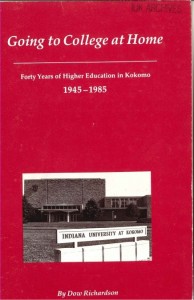By: Jessica Gordon, Bicentennial Intern, Class of 2017, General Studies with a focus in Arts and Humanities, Kokomo
I began working on the Oral History project roughly mid-September 2016. Since then, I have been gathering information and reading resources to help me as I prepare for interviews and collect oral histories of individuals that have been influenced by Indiana University Kokomo. My supervisor is, Diane J. Bever, IU Kokomo Library librarian. I have been assisting her in archive work for two of my three years as a student assistant in the library here on the Kokomo campus.
I was glad I had some prior experience in our archive collection, because it has helped me connect names to faces as I work on this project. My first task was to check the oral histories we already have to count the number of resources in the files. These include: transcripts, mini cassettes, VHS tapes, and some even have photographs. The archive files we already have will help us to decide who we should contact to be interviewed.
My supervisor provided me with materials to read to gain some knowledge about the history of the Kokomo campus.These books were Going to College at Home: Forty Years of Higher Education in Kokomo, authored by Dow Richardson (1985) and Coming of Age 50 Years of Higher Education in Kokomo (a pictorial history) compiled by Linda Ferries, Susanne Ridlen, Allen Safianow, and Timothy Sehr (1997).
 I found these resources to be very helpful. I began attending IU Kokomo in 2013, and I had not thought much about how it became the campus it is today until I started working on this project. Exploring the two books certainly helped me to get a glimpse into all the hard work it took to not only start IU Kokomo in 1945, but also to purchase more land and buildings to help it become the established campus it is today.
I found these resources to be very helpful. I began attending IU Kokomo in 2013, and I had not thought much about how it became the campus it is today until I started working on this project. Exploring the two books certainly helped me to get a glimpse into all the hard work it took to not only start IU Kokomo in 1945, but also to purchase more land and buildings to help it become the established campus it is today.
The campus started in 1945 with the establishment of the IU Extension Center on West Taylor Street. When the climbing student population grew too large for this building, IU at the instigation of President Herman B Wells, purchased additional property and moved to West Sycamore Street to the Seiberling Mansion.
The Seiberling Mansion along with the two carriage houses in the rear which have been preserved, are now home to the Howard County Historical Museum. President Herman B Wells met with a committee years later to plan to build a larger campus, which is now located on South Washington Street.
There was a lot that happened between then and now, but it is all too important to quickly detail here.
The part that I enjoyed the most from reading the provided resources was the pictorial history in Coming of Age. I am a visual learner and also have a passion for photography, so I very much enjoyed seeing the photographs of what the campus looked like in the past. Viewing photographs is one of the reasons that I am looking forward to interviewing individuals.
In one of the pointers from the Howard County Historical Society’s Oral History Guidelines that my supervisor Diane provided me with, it suggested asking individuals ahead of time if they had any photos to contribute to the histories and that these can be used to ask new questions as well as keep the conversation moving. I thought this was a really great idea! It is great to hear history, but it is also beneficial to see it as it happened.


For this project, my supervisor and I are interested most in interviewing retired individuals or soon retiring, alumni, and also individuals involved in campus projects such as the Innovation Symposium, clubs, and various activities. I have found great information online about specific interviewing techniques as this will be the next step in the project. I would have to say I am most nervous about silence. The guidelines also said, “Don’t be afraid of silence. Give the interviewee time to reflect on the question and to compose a careful answer.” It suggests that the interviewer provide some prompts if necessary to assist in recalling information. I appreciate the information these guidelines have given me. I feel more at ease about conducting an interview now.
Along with interviewing people who are a part of the history of IU Kokomo, I am also updating the campus timeline. We are looking to add in information about IU Kokomo chancellors as well as building construction if not already listed. This project has already taught me so much and given me a better appreciation for the changes the campus has made since its start. I am looking forward to finding out more about the history of IU Kokomo as I continue this project!

Read more about the campus wide oral history project here:
https://blogs.iu.edu/bicentennialblogs/2016/11/23/iu-northwest-oral-history-project/
https://blogs.iu.edu/bicentennialblogs/2016/11/08/oral-history-project-at-iu-east/
https://blogs.iu.edu/bicentennialblogs/2016/11/14/165/
https://blogs.iu.edu/bicentennialblogs/2016/11/14/staring-the-journey-oral-history-at-iu-southeast/
https://blogs.iu.edu/bicentennialblogs/2016/11/07/ipfws-oral-history-project/